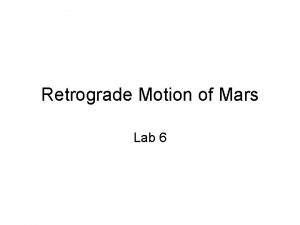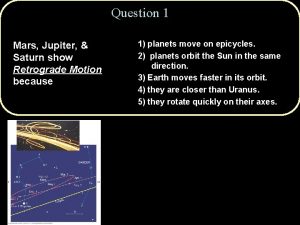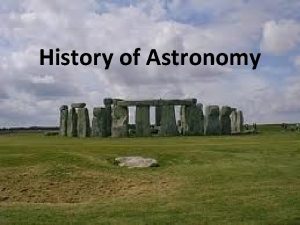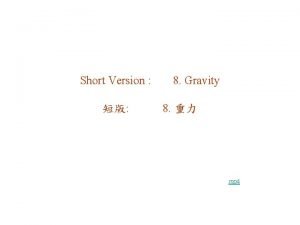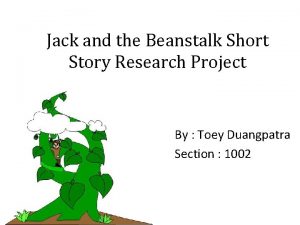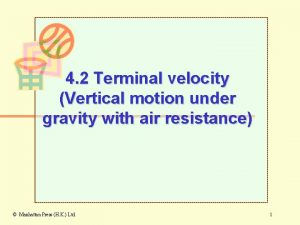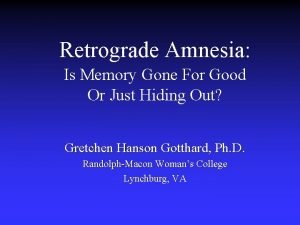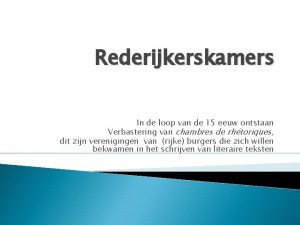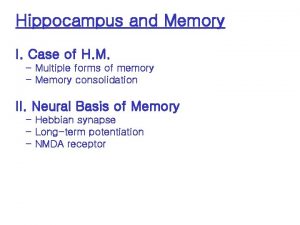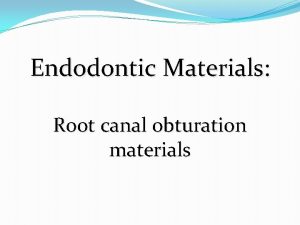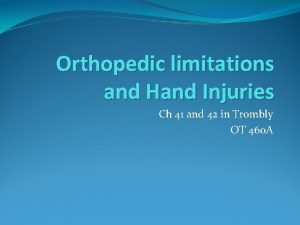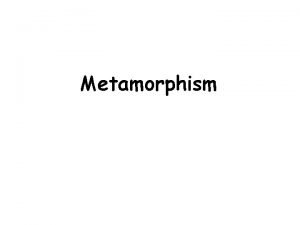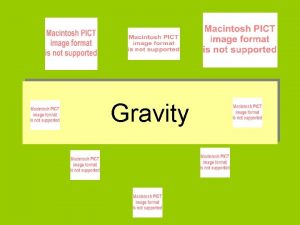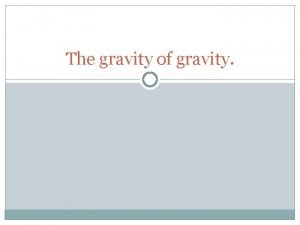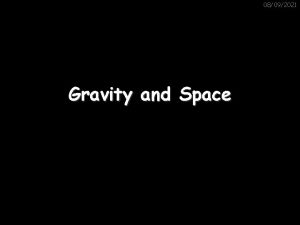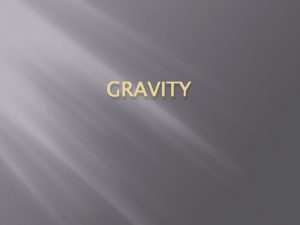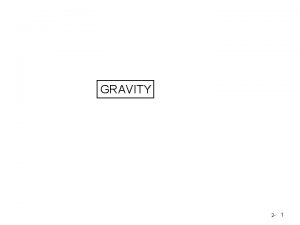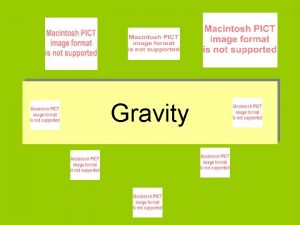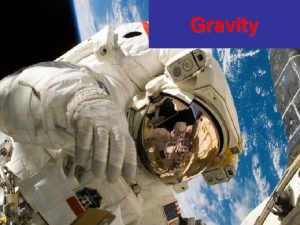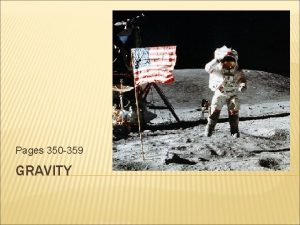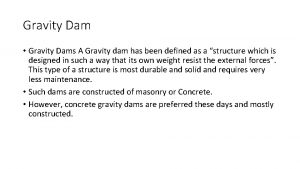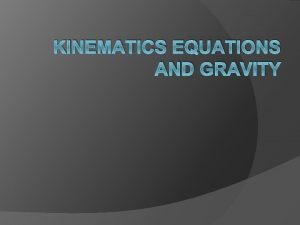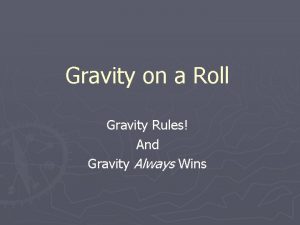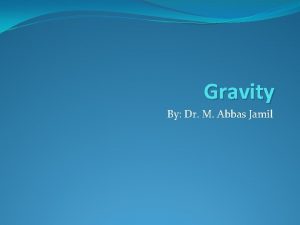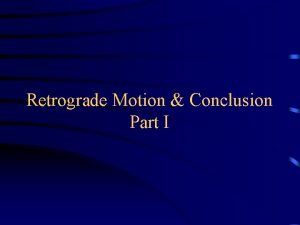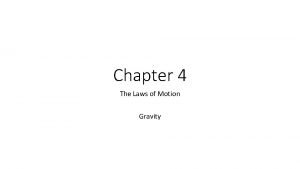Short Version 8 Gravity Retrograde Motion Retrograde motion



















- Slides: 19

Short Version : 8. Gravity

Retrograde Motion Retrograde motion of Mars. As explained by Ptolemy.

Ptolemaic (Geo-Centric) System epicycle equant deferent swf

Cassini Apparent Sun Venus

8. 1. Toward a Law of Gravity 1543: Copernicus – Helio-centric theory. 1593: Tycho Brahe – Planetary obs. 1592 -1610: Galileo – Jupiter’s moons, sunspots, phases of Venus. 1609 -19: Kepler’s Laws 1687: Newton – Universal gravitation. Phases of Venus: Size would be constant in a geocentric system.

Kepler’s Laws Explains retrograde motion Mathematica

8. 2. Universal Gravitation Newton’s law of universal gravitation: m 1 & m 2 are 2 point masses. r 12 = position vector from 1 to 2. F 12 = force of 1 on 2. G = Constant of universal gravitation = 6. 67 10 11 N m 2 / kg 2. F 12 m 1 r 12 Law also applies to spherical masses.

Example 8. 1. Acceleration of Gravity Use the law of gravitation to find the acceleration of gravity (a) at Earth’s surface. (b) at the 380 -km altitude of the International Space Station. (c) on the surface of Mars. (a) (b) (c) see App. E

Cavendish Experiment: Weighing the Earth ME can be calculated if g, G, & RE are known. Cavendish: G determined using two 5 cm & two 30 cm diameter lead spheres.

8. 3. Orbital Motion Orbital motion: Motion of object due to gravity from another larger body. E. g. Sun orbits the center of our galaxy with a period of ~200 million yrs. Newton’s “thought experiment” g=0 Condition for circular orbit Speed for circular orbit projectiles Orbital period Kepler’s 3 rd law

Example 8. 3. Geosynchronous Orbit What altitude is required for geosynchronous orbits? Altitude = r RE Earth circumference = Earth not perfect sphere orbital correction required every few weeks.

Elliptical Orbits Projectile trajectory is parabolic only if curvature of Earth is neglected. ellipse Orbits of most known comets, are highly elliptical. Perihelion: closest point to sun. Aphelion: furthest point from sun.

Open Orbits Open (hyperbola ) Closed (circle) Borderline (parabola) Closed (ellipse) Mathematica

8. 4. Gravitational Energy How much energy is required to boost a satellite to geosynchronous orbit? U 12 depends only on radial positions. U = 0 on this path … so U 12 is the same as if we start here.

Zero of Potential Energy Gravitational potential energy E > 0, open orbit E < 0, closed orbit Bounded motion Turning point Open Closed

Energy in Circular Orbits Circular orbits: r > r 0 K E K U Higher K or v Lower E & orbit (r). To catch the satellite, the shuttle needs to lose energy. It does so by turning to fire its engine opposite its direction of motion. It drops lower, turns again , and fires its engine to achieve a circular orbit, now faster and lower than before. Mathematica

energy Altitude 0 K E = K+U = U / 2 K>K E = K +U < E ( K < K ) h h<h U U<U UG 0

8. 5. The Gravitational Field Two descriptions of gravity: 1. body attracts another body (action-at-a-distance) 2. Body creates gravitational field. Field acts on another body. near earth Near Earth: Large scale: Action-at-a-distance instantaneous messages Field theory finite propagation of information Only field theory agrees with relativity. in space Great advantage of the field approach: No need to know how the field is produced.

Application: Tide Moon’s tidal (differential) force field at Earth’s surface Moon’s tidal (differential) force field near Earth Two tidal bulges Mathematica Sun + Moon tides with varying strength. Tidal forces cause internal heating of Jupiter’s moons. They also contribute to formation of planetary rings.
 Tall+short h
Tall+short h Gravity for dummies and dummies for gravity equations
Gravity for dummies and dummies for gravity equations Mars retrograde motion animation
Mars retrograde motion animation Mars, jupiter, and saturn show retrograde motion because
Mars, jupiter, and saturn show retrograde motion because Stonehenge planetary orbits
Stonehenge planetary orbits Retrograde motion of mars
Retrograde motion of mars Jack and the beanstalk short story summary
Jack and the beanstalk short story summary Rotational motion and the law of gravity
Rotational motion and the law of gravity Vertical motion under gravity
Vertical motion under gravity Lesson 4 gravity and motion lesson review
Lesson 4 gravity and motion lesson review Retrograde amnesia
Retrograde amnesia Dichtvormen rederijkers
Dichtvormen rederijkers Neuropsychology near eldridge
Neuropsychology near eldridge Bezugskostenrechnung
Bezugskostenrechnung Anterograde vs retrograde amnesia
Anterograde vs retrograde amnesia Diaket
Diaket Orthograde vs retrograde root filling
Orthograde vs retrograde root filling Anterograde vs retrograde amnesia
Anterograde vs retrograde amnesia Manual edema mobilization vs retrograde massage
Manual edema mobilization vs retrograde massage Prograde and retrograde metamorphism venn diagram
Prograde and retrograde metamorphism venn diagram


